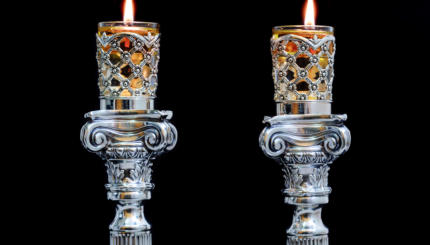Excerpted from A Guide to Jewish Prayer with permission of the publisher, Schocken Books.
During the course of the year, there are various days of fasting on which, in addition to the fast itself, there are a number of changes and additions in the order of prayer services. (Yom Kippur, although a day of fasting, is not considered among these, because it is essentially a festival, and the fasting on that day is intended for purification and spiritual elevation).
The fast days may be categorized, on the basis of their essence and the customs practiced on them, as follows: (a) Tisha B’Av (the Ninth of Av), whose laws, customs, and prayers give it a unique status; (b) fast days held in memory of tragic events: some are mentioned in the Bible; other, later ones, are either recognized by all Jewish communities, or are kept only by particular communities; (c) fixed fast days for atonement and purification; (d) other fixed fasts; (e) fast days declared on the occasion of public calamities, whenever they occur.
The Service on Memorial Fast Days
All these [memorial] fast days share a common pattern of laws and customs. The fast itself only applies during the daytime (from dawn till nightfall). When one of these days occurs on Shabbat, it is postponed to Sunday. The Fast of Esther is not postponed till the following day, because that day is Purim; instead, it is brought forward to Thursday, as Friday is also not an appropriate day for fasting (the one exception to this is the Tenth of Tevet, on which we fast even when it falls, as it occasionally does, on a Friday).
The Ma’ariv [evening] service is conducted as on regular weekdays (since the fast doesn’t begin until the following morning).
Shaharit [morning service], through the Amidah [central standing prayer]remains the same as on weekdays. The Shaliah Tzibbur [service leader] repeats the Amidah as on weekdays, but after Go’el Yisrael [the benediction "Redeemer of Israel"]he adds Anenu ["answer us"]as a complete benediction, which ends with the words "Blessed are You, O Lord, who answers [His people Israel] in times of distress."
In some Ashkenazic congregations, it is customary for the Shaliah Tzibbur to intersperse a number of Selichot Piyyutim [penitential poems]among the benedictions of the Amidah. After the repetition of the Amidah, most Ashkenazim–Eastern European-descended–as well as Nusah Sepharad (Mediterranean-region tradition) worshippers recite special Selihot for that day, concluding with Avinu Malkenu [Our Father, our King](with slight variations from the formulation recited during the Ten Days of Awe, because this is not the beginning of the year), and followed by Tahanun, the penitential prayer.
This is followed by a Torah reading, to which three persons are called up, from the section dealing with God’s pardoning the people for the sin of the Golden Calf (Exodus 32:11-14; 34:1-10). In many communities, it is customary for the congregants to recite aloud the verse "Turn from Your wrath. . ." (Exodus 32:13), the Thirteen Attributes of Mercy, and the phrase "And pardon our iniquity, our sin, and take us for Your inheritance," and for the reader to repeat these words after them. After the Torah reading, the service is concluded as usual for weekdays.
In the Land of Israel, there are those who wear Tallit and Tefillin at Minhah (the afternoon prayer) especially among the Oriental communities. …A Torah scroll is taken out, and the same portion is read as in Shaharit.
Torah
Pronunced: TORE-uh, Origin: Hebrew, the Five Books of Moses.


